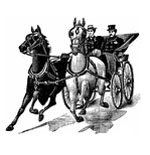
Lessons From the Amish
LETTER FROM EUROPE
West of Strasbourg, my home city on the French-German border, lie the Vosges mountains. Unlike the Alps or the Rockies, but like the Appalachians, they present no towering peaks: The centuries have worn them down into a magical landscape of undulating hills and valleys. In the Middle Ages — indeed, to the end of the Thirty Years War — they were the epitome of political decentralization, dotted with hundreds of castles and dependent villages under the aegis of petty and competing territorial lords. The fairytale villages and the castle ruins contribute mightily today to the charm of the area for locals and tourists alike.
Ideologically and religiously, the Vosges have also been characterized by decentralization: a region of the out-of-the-ordinary, the mystical, the unique. The area is rich in folklore, centering on semi-transcendent beings (giants, ogres, fairies, and their ilk). The medieval monastery of Sainte Odile is a kind of local Lourdes, with emphasis upon miraculous healings. In the obscure village of Waldersbach in the late 18th century, Lutheran pastor Jean Frederic Oberlin set forth his remarkable educational techniques for the religious (later, secular) instruction of children. And in those same mountains the Amish sect developed one of its most important centers of influence prior to resettlement in America.
On the occasion of the 300th anniversary of the Amish schism from mainline Anabaptism, a major international symposium on the Amish contribution has just taken place in the Alsatian village of Sainte-Marie-aux-Mines (August 19-22, 1993). This International Amish Colloquium gives us an opportunity to consider the Amish phenomenon and to draw some theological lessons from a fascinating byway in the history of Christian thought.
The roots of Alsatian Anabaptism lay in the Swiss radical pacifists of Zurich at the beginning of the 16th century. Ejected by Swiss political authorities, these Anabaptists (so-called, of course, because they rejected infant baptism in favor of adult conversion) spread up the Rhine as far as the Netherlands. Their settlements were invariably rural, so as to avoid the temptations, pressures, and persecutions of city life. The Alsace was an especially hospitable location, owing to the fact that Strasbourg was a free city of the Holy Roman Empire; its dependencies were therefore less subject to hierarchical political and ecclesiastical control. Many of the dissidents settled in the valley of Liepvre and eventually took over land abandoned during the Thirty Years War. The result was a thriving agricultural community, characterized by industry, thrift, and the development of advanced farming techniques.
You May Also Enjoy
England is the preeminent country for the celebration of Christmas. Blessed with Dickens and no…
In March I flew across the pond to deliver a guest lecture in the 24th…
Don’t tell me that intellectual standards are declining in England. Where in the U.S. could…

